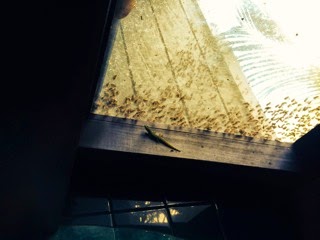In recent inspections I had removed the drone frames. The bees just were not drawing much comb on them. Drone brood culling is one method of Varroa control but I did not want to remove the regular frames with that had plenty of capped drone brood. I should probably get a
capping scratcher to remove as many drones as I can. I left the drone frames on top of Olea's hive. This bee was gleaning propolis- you can see her booty on her corbicula or pollen basket.
Hive #1. After returning from Hawaii, I noticed that the activity around the entrance was less than around the other hives, so I inspected it first. I looked into every box. My subjective impression was that there were fewer bees than before. I saw no eggs, larvae or capped brood and did not spot the queen. My first
pessimistic conclusion was that the colony was queenless and dying. But I did come up with a more
optimistic theory that fits all the facts, i.e., while we were away the colony cast a swarm (explaining fewer bees) and the new queen has not yet started laying. I did not see here because new queens are very shy and quick. I will wait a couple of weeks and then check for signs queen activity. I was concerned that there might be too much space in the hive for the bees to effectively patrol for
wax moths so I put the bee escape board in and removed the top super. I ultimately placed the super on #3. I am also keeping a lookout for
robbing activity; if/when I see any, I will replace the entrance reducer.
Hive #2. This one now seems to be the strongest. I spotted the queen in the top brood box and watched
her lay three eggs. (If I had my own
GoPro, you would get some great pictures and videos, clue, clue.)Most of the brood is in the top brood box, but there is some in the bottom box. There were
a lot of drones all over. The drone frame in this hive and very irregular comb, many drone cells and some capped honey. I took it out and inspected the pupae for mites. I only looked at six and found four mites! I did not replace the drone frame, but I have just now decided to get a scraper and use it assiduously
Hive #3. There still is cross-combing, but I think it may be a bit better. The number of bees looks good. There is honey in top box as well as drone brood. I did not go into the bottom box. Placed honey super from #1 (that had some honey already in it) on top.








